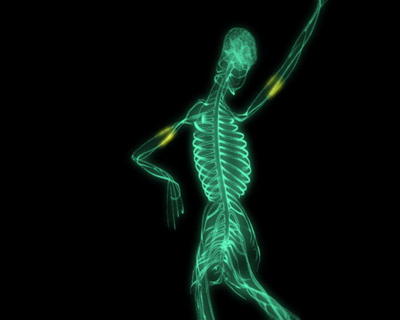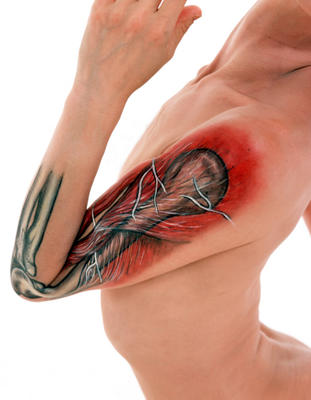The Dancer's Body

The Dancer's Body, a coproduction between BBC Science and BBC Classical Music, begins tonight (Saturday 21st) on BBC2 at 8.15 pm.
When Jana Bennett, now Director of BBC Television, was the Corporation’s Head of Science, she gave this advice to her producers: “Aim High. Aim Right. And do not hesitate to look ‘drop dead expensive’”. The Dancer’s Body is the quintessence of Bennett’s approach to television. It is very much ‘Tiffany TV’, with high production values and it will be eminently saleable outside the UK. It is good science and dance audiences will also find a great deal to engage them.
The presenter, Deborah Bull, is a producer’s dream, with an enviable ability to improvise a piece to camera (PTC), be it from the Busby Berkeley swimming pool routine that marks Programme 1’s opening sequence, to her simultaneous Swan Queen solo and accompanying PTC in programme 2.
Programme 1 explores, very fluently, the physiology of performance, while programme 2 examines the dancer’s brain. Dance footage buttresses the argument at every point; in programme 1 the Corsaire male solo, a duet between Bull and Edward Watson from Symbionts, the Bluebird solo from Sleeping Beauty, a sequence from Balanchine’s Apollo and the closing pas-de-deux from Don Quixote.
The conversation between art and science, on which the programme depends, is deftly done. The role of genetic inheritance is explored, as is that of nurture. The programme’s case histories do not draw on dancers alone. A gymnast illustrates the role of muscle fibres; a wirewalker that of balance; and a speed-cyclist that of the difficulties of intense short-term spurts of energy.
Nilas Martins of New York City Ballet illustrates the wear and tear endured by male dancers in late career. Roles such as Balanchine’s Apollo, in which he is seen briefly, are particularly punishing; when landing, pressure on the knee and ankle joints is enormous and they regularly absorb forces fifteen times the dancer’s body weight. The cameras follow him into the operating theatre, where surgeons remove two bone spurs that had grown on his ankle. This is definitely not for the squeamish.
A telling sequence shows Ivan Putrov in the Bluebird solo from Sleeping Beauty. Male ballet solos of such intensity only last a minute or two. It is not a matter of the choreographer’s creativity or the dancer’s tiredness; the limiting factor is the build up of lactic acid in the muscles. An illustrative comparison is made with speed cycling. Victoria Pendleton explains that she can manage only short spurts of maximum effort, twelve seconds at most. Bull mounts a bike and cycles around a velodrome. After one minute she is visibly palling.
It is difficult for a programme like this to maintain a focused thread of argument and it is inevitably episodic. A film sequence of Jonathan Cope explaining how he partners Marianella Nunez, leads to a discussion of ‘spotting’ and a laboratory experiment in which Bull is swivelled in a chair until she becomes dizzy herself. There is a demonstration of how spotting neutralises dizziness.
One of programme 1’s more extraordinary sequences features Bill Shannon, who has malformed hip joints and who cannot walk without crutches. He learnt to dance on the hip-hop scene and he is filmed in a scarifying skateboard dance on the streets of New York. He distributes his weight across his arms and legs and crutches in a style unique to his body. Shannon gives the lie to any preconception that there is an archetypal dancing body. To underscore the point, Bull ends the programme with a sequence from a ballet, Slice of Paradise, choreographed by the French ensemble Montalvo/Hervieu, in which she herself dances alongside break dancers, contemporary dancers and one extraordinary African dancer who compels attention.
The Dancer’s Brain
The meat of the series is reached in the second programme in which Bull investigates the complex issues of learning and memory. Again, Bull reaches outside dance for some of her most telling case histories, notably that of Ian Waterman, who had lost all sense of proprioception – in simple language, the loss of sense that his limbs would act on the instructions of his brain. Such assurance children develop slowly; that is, in part why we move more fluently as adults than as children.
That sense is crucial to dancers who move hundreds of muscles in highly specific sequences in order to produce performance. In a charming sequence, Bull revisits her first ballet teacher and her first dance school overhead chip shops and amusement arcades in Skegness. A neurologist explains how children learn proprioception and the Kathak performer, Akram Khan illustrates complexity of moving limbs in independent sequence. The brain resists such movements initially. The body copes by developing mini-networks of muscle memory. Dancers command them, Bull explains, as “a package deal.”
A highly impressive laboratory experiment demonstrates what happens in dancers’ brains when they dance. Bull has her brain scanned, first when watching an orchestral version of the Shostakovich score to Kenneth MacMillan’s Concerto, which she had been rehearsing, and then when watching a danced performance. A neuroscientist measured the contrasts in brain activity. Bull’s brain was uniquely activated in the premotor cortex part of her brain; this was also the case when she was asked to imagine the movement without aid of an actual video. It was powerful supporting evidence for the role of ‘imaging’, of imagining steps before performing them. It strengthens ‘neural pathways’ and reinforces the case for a brain as well as a body warm-up before performance.
Particular resonant for a ballet audience is that part of programme 2 in which Anthony Dowell teaches Jonathan Cope the role in Four Schumann Pieces, created for him in 1970 by Hans Van Manen, which he last danced 20 years ago. The original Benesh notator, Jacqui Hollander, watches as he attempts to remember the choreography:
Dowell “I think I had to wait here with the hands clasped and the lifts went behind me and on a certain note I had to listen and look – here I did something like this.
Hollander You’re turning the wrong way! The way it was done, Anthony, was for you to turn left!”
It is fascinating to watch Dowell as his memory is teased into life, while Henry Roche plays the piano score. The music clearly stimulates him. He blanks. “Double tours – no longer I’ve blocked that out!” In this case there is a video as well as a notated record. What is evident is that the outline remains, but that “the little things go.”.
Programme 2 finishes with a solo for Bull by the choreographer Alita Collins. Set to Aaron Copland’s Burlesque, it is ‘big and sassy’; and danced in high heels, rather than Bull’s accustomed pointe shoes. Bull explains that ballet steps are to her second nature; a piece such as this taxes nerve cells in different ways, built as it it from other styles and the choreographer’s own inventions. She explains how she fumbles as her brain works out how to handle the choreography; apparently it takes 180 repetitions for a new muscle memory to stick in the brain.
The production team
Although the executive producers are Bob Lockyer and Ross MacGibbon, both of whom are highly experienced in making dance programmes for TV, the production team that made The Dancer's Body was led by Robert Eagle and comes from a science background. BBC Science has been one of the most consistently innovative BBC production departments, and one which has been consistently successful both in receiving channel commissions and in forging co-production alliances outside the UK. A series such The Dancer's Body is born of the present Director General's wish for multi-genre programmes, that is to say, productions which owe their origins to several different BBC programme traditions at once. It is a creative success - popular science with strong entertainment values, which nonetheless will appeal to a serious dance audience.
The programme's website is a considerable success in its own right. It has many video clips from the series, but, crucially, it enlarges on the science behind the programmes and enlarges it in a way in which the broadcast script could not reasonably do so.

The final Dancer’s Body explores how audiences react to dance. In an experiment the programme commissioned a piece of choreography from David Bintley. It was shown to a selected audience, some of who knew little of dance. They were then asked for their reactions.
The programme is differently paced to the previous two, more wordy and carrying a greater burden of scientific explanation. Its starting premise is that body language is deeper and truer than the spoken word, revealing more without necessarily intending to do so. The power of dance is that it is licensed to ‘say the unsayable’. The erotic postures of the tango are ‘safe’ on a dance-floor, but not so, once the music stops. The theatre’s controlled environment, Bull suggests, is a safe place to explore dangerous ideas.
At what level do we understand body language? Ballet uses the body to tell stories, but it has narrative limitations. The use of mime in nineteenth century ballets was intended to overcome these. In an illuminating piece to camera, Deborah Bull mimes the phrase “You hear me speak”. She then asked some random interviewees in Covent Garden Piazza to decipher her gestures. They failed utterly to grasp the intended meanings. Then follows an extraordinary piece-to-camera. Bull is now Odette and wears a white tutu. She dances Odette’s mime from Swan Lake Act II, all the while speaking the words - “Over there is a lake of my mothers’ tears. Over there is a man who is angry. He turns me into a swan, but, if there is one who loved me, would marry and be with me forever, I would be a swan no more.” It is truly priceless.
Twentieth century ballet eschewed mime and turned to abstraction using the language of the body to transmit meaning. David Bintley and a second choreographer, Wayne McGregor, were each commissioned to create a short ballet based on a legend from an Athenian wine jug dated 740 BC. It reads: “Whoever of all the dancers shall perform most nimbly shall win this jug as a prize.” It is the first preserved example of the written Greek alphabet and it is doubly interesting that it should refer to dance.
McGregor’s response was ‘Bodyscript’ a duet for Bull and English National Ballet’s Thomas Edur. Instead of interpreting the content of the text, McGregor chose instead to work from the shape and texture of the lettering on the jug. The piece, albeit short, is immensely attractive. While it is completely characteristic of McGregor, with its slices and lunges, it is also recognisably classical. To see Edur, in particular, cast in this way, is a revelation.
Bintley’s offering, in contrast, explores the text and its possible meanings. His duet for Alessandro Molin and Deborah Bull, set to Satie’s Gymnopedies, explores the human fascination with symmetry. He reaches for images from Greek wrestling as a metaphor for sex, love and dancing.
The final Dancer’s Body is on BBC2 this coming Saturday at the earlier time of 7.10pm. Wayne McGregor’s Bodyline is available online now at the Dancer’s Body website. David Bintley’s Gymnopedies will be available in the next few days
